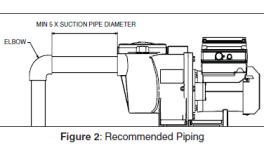Hi all, I did a lot of research, and I'm finding it tough to know if I will be putting the pool plumbing components in the right order.
Any advice is greatly appreciated!
I just installed a 9-ft. by 13-ft. by 4-ft.-deep semi-inground pool with a vinyl liner.
A waterproof plumbing pad will be about 10 to 15 ft. away in a nearby shed where the floor is about 3 ft. below the water level in the pool—so all of the plumbing is slightly below the level of the top of the pool water, but above the bottom of the pool.
There is one skimmer and one return inlet on one long side of the pool, and there is another return inlet on the other long side. I'm running about 15-20 feet of 2-in. PVC from the skimmer, and I was considering running a dedicated 1.5-in. line for each of the returns.
I'm trying to figure out the best layout for all the parts in the shed, and I'm thinking the following makes sense...but let me know:
My main questions are:
- Rob
(below is a very rough layout of just the plumbing pipes running between the pad and the pool)
Any advice is greatly appreciated!
I just installed a 9-ft. by 13-ft. by 4-ft.-deep semi-inground pool with a vinyl liner.
A waterproof plumbing pad will be about 10 to 15 ft. away in a nearby shed where the floor is about 3 ft. below the water level in the pool—so all of the plumbing is slightly below the level of the top of the pool water, but above the bottom of the pool.
There is one skimmer and one return inlet on one long side of the pool, and there is another return inlet on the other long side. I'm running about 15-20 feet of 2-in. PVC from the skimmer, and I was considering running a dedicated 1.5-in. line for each of the returns.
I'm trying to figure out the best layout for all the parts in the shed, and I'm thinking the following makes sense...but let me know:
- 2 inch line from skimmer coming out of the shed floor
- 2 inch ball valve
- pool pump (with unions on both ends)
- cartridge filter (with unions on both ends)
- 2 inch check valve
- zinc anode
- inline chlorinator
- (with unions on both ends; might replace with SWG eventually)
- Jandy style 3-port valve
- two 2 inch to 1.5 inch reducers
- two 1.5 inch lines, each directly to one of the return inlets
My main questions are:
- Do I only need one check valve?
- If so, do I have it in the right location?
- If I need more than one check valve, where do they go?
- Is it unnecessary to have a Jandy valve splitting the flow to the two return lines? (could I just have a ball valve before I split the plumbing...meaning will I never have a reason to adjust the flow between the return or turn one off and have the other on?)
- Should I have any valve allowing me to drain the system? (if I don't need the Jandy valve for the returns, I could put the valve some where in the system to allow the extra port to be a drain.)
- Rob
(below is a very rough layout of just the plumbing pipes running between the pad and the pool)
Pool survey overlay.png
Rough location of 9x13 semi-inground pool, including suction and return lines
pool-backfilled.jpg
Playgo 9x13 semi-ingrouind insulated pool after backfilling and retaining wall but before deck...
pool-plumbing-parts.jpg
Assorted plumbing parts for my new 3500 gallon semi-inground pool
Attachments
Last edited:












